If you’re looking to use social selling to grow your business, LinkedIn is the place to go. A full 70 percent of professionals that sell on social media prefer LinkedIn over all other channels.
Of course, this is a bit of a double-edged sword.
On the one hand, if most professionals use LinkedIn for social selling, it means there are definitely a ton of opportunities to be had there.
On the other hand, this also means you’ll have a ton of competition to deal with.
Not to worry, though:
LeadFeeder’s CMO, Andy Culligan, recently sat down with the co-founder of DLAignite, Alexander Low, to discuss how to get started with social selling on LinkedIn.
If you don’t have the time to check out the full webinar right now, feel free to check out a summary below the video.
Note: Want to get a head start on targeting the right audience on LinkedIn? Use You can try Leadfeeder free for 14 days here to see what companies visiting your site—and target others just like them.
What is social selling, & why should you be using it?
To open the webinar, Low gives an explanation of what social selling actually is:
“Social selling is how you use your social media to engage with your audience.”
As you know, there are many, many ways to engage with your target audience on different social media platforms.
Social selling is about using these features and functions to deepen your relationship with your prospects and customers.
In fact, brands that use social selling uncover 45 percent more opportunities, and are 51 percent more likely to achieve quota than teams that do not.
(Chances are, these companies have also been able to make the best of the current global shutdown due to COVID-19.)
Still, Low explains that social selling is not meant to replace your current marketing and sales initiatives.
Rather, it’s meant to augment and complement your other efforts.
Through social selling on LinkedIn, you can easily connect with potential customers in authentic and personal ways.
From there, it’s a matter of staying connected with the right leads, and keeping them on the path to conversion.
Now, let’s take a look at how Low puts social selling into action.
Social selling on LinkedIn 101
In his webinar, Low breaks down three key aspects of social selling on LinkedIn:
Optimizing your LinkedIn profile
Growing your network
Using content to engage with your target audience
Here’s what he had to say.
Optimizing your LinkedIn profile
Your profile page is one of the first things your new connections will see when engaging with you.
And first impressions matter.
Not only that, but your LinkedIn profile is where potential clients will go to learn more about who you are, and what you can offer them.
For both reasons, it’s crucial that you flesh out your LinkedIn profile completely and strategically.
Here are some key things to consider as you fill out each section of your profile.
Banner image
Though often overlooked, your profile’s banner image makes a huge difference in how your audience views your brand.
In fact, LinkedIn’s annual report shows that professionals with a branded and aesthetically-pleasing banner image see higher-than-average click-through rates.
If you don’t have a graphic designer, Canva provides a number of templates specifically for LinkedIn banner photos.
Just make sure it matches your brand—and aligns with your profile photo.
Profile photo
This is pretty straightforward:
Your profile photo should be professional and high in quality.

This isn’t your personal Facebook or Instagram.
It’s your business’ LinkedIn profile—and you need to dress for the occasion.
Headline
For social selling purposes, you’ll be approaching your LinkedIn headline a bit differently than you would as a job candidate.
Instead of listing a job title, use your headline to explain exactly what it is you do for your target customer.
If you have a clear, concise, and customer-facing headline in mind: Great!
If not, just ask your current customers to describe what you do for them. Then, play around with their feedback until you find just the right way to describe your services.
About section
Your About section should piggyback off of your headline, diving deeper into the services and overall value you provide your customers.
Here’s how Low’s About section looks:
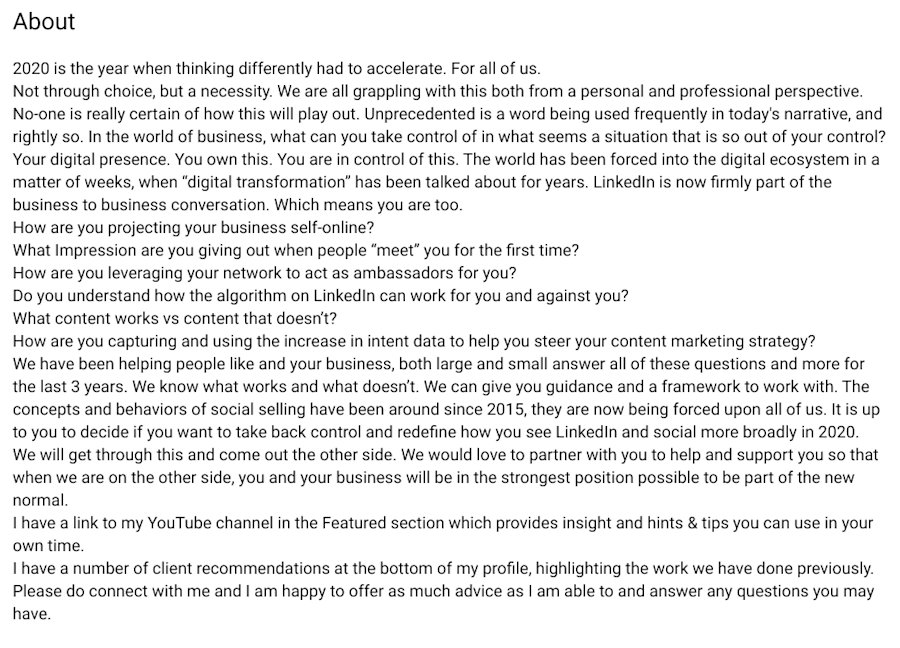
Note that he doesn’t start by talking about what he does.
Rather, his aim is to:
Empathize with the reader (his potential customers)
Get them to think more deeply about their current situation
Then get them to start thinking about how he can help them
Featured content
The Featured section is LinkedIn’s newest addition, allowing you to showcase selected content to your audience.
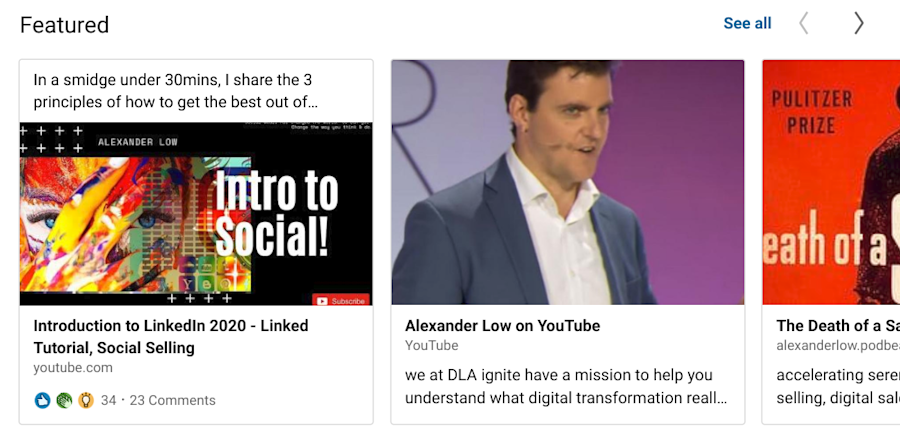
This can be content you’ve created and posted on LinkedIn, or it can be from any other channel you’re active on.
As discussed later on in the webinar, the content you promote here should be that which has proven to be most engaging to your target audience—not just content you think they want to see.
Experience
The Experience section is where you can reinforce the value of your services.
For example, Low revisits the hypothetical questions he asked in his About section, allowing his audience to think more on the subjects:

Note that you can include multiple business ventures within your history—as long as they’re relevant to your current knowledge and skillbase.
Education and licenses & certifications
For social selling purposes, you’ll be filling these sections out for two key purposes:
First, the obvious: It allows you to showcase your expertise and qualifications to anyone who visits your page.
What’s more, it gives you common ground to stand on when engaging with potential clients who have similar backgrounds.

(While you’ll quickly want to forge a deeper connection with these prospects, it can’t hurt to start with a surface-level commonality, right?)
Skills and endorsements, and recommendations
To flesh out these sections, you’ll need a little help from your current customers.
For the skills and endorsements section, you’ll list any skills you have that are relevant to your services—then request endorsements from those familiar with your work.
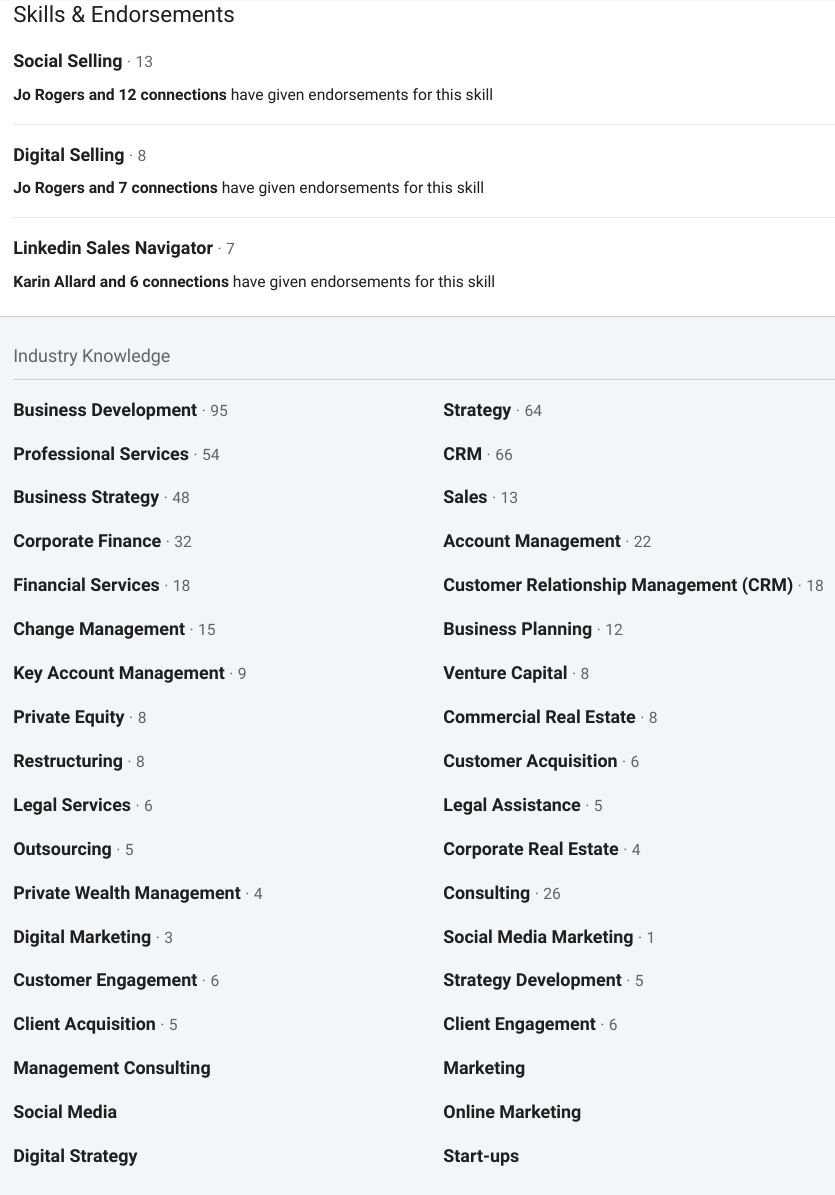
You can list up to 1,000 skills, so be sure to select as many that apply as you can. But, also be sure to gather authentic and accurate endorsements from others in your network.
The recommendations section is where you can collect social proof from your followers and customers.
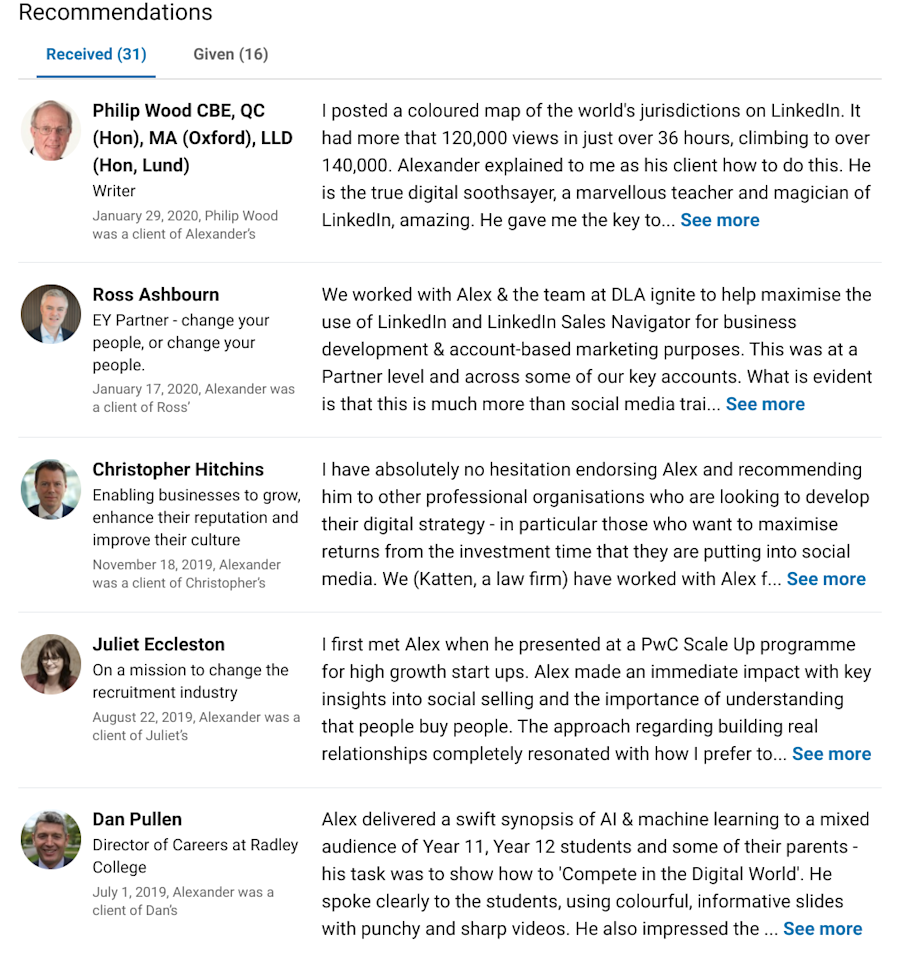
The best time to ask for a recommendation?
Right after you provide top-notch service to a client, or immediately after they experience success with your offering.
That way, they’ll not only be excited to talk about your brand—they’ll also have a lot to say, too.
Once your LinkedIn profile is more fleshed-out and up-to-date, you’ll be ready to start engaging with potential customers.
Beginning to grow your LinkedIn network
To start growing your LinkedIn network, you’ll want to focus on those who fit your target persona(s) who also belong to your current followers’ networks.
Here’s how to do it:
First, search for your target customer’s title on LinkedIn, then click “People.”

Then, click All Filters, then check off the “2nd” option under Connections:
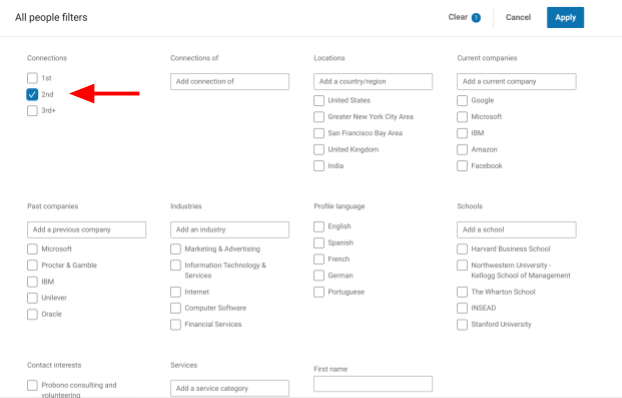
You can then narrow down the field to your liking. This may mean searching for CMOs from different locations, in different industries, or who have worked with specific companies.
But, above all else, they need to belong to at least one of your follower’s networks.
First of all, it gives you an “in” should you want to directly connect with an individual.
This works best when you have a close relationship with an acquaintance who knows someone in need of your services.
It also increases the chances that you’ll cross virtual paths with these individuals simply by engaging with your common acquaintance—and by sharing content they’re interested in.
Which brings us to the last part of the webinar…
Using content to engage your target audience
Overall, content is the key to social selling on LinkedIn.
There are a number of ways to use content to engage with your target audience on LinkedIn, such as:
Liking and commenting on content shared by others
Curating and sharing other people’s content
Creating and sharing your own content with others (within and outside of your network)
Let’s take a closer look at what this all entails
Customizing your newsfeed
LinkedIn’s algorithm works to deliver content to your newsfeed based on your interests and on-site behavior.
Basically, the more you interact with a certain person, brand, or type of content, the more likely you are to see updates surrounding these areas.
You can also take more active control of what you see on your newsfeed by using LinkedIn’s “Improve My Feed” feature.
This can be found by clicking the ellipses in the top right corner of any post:
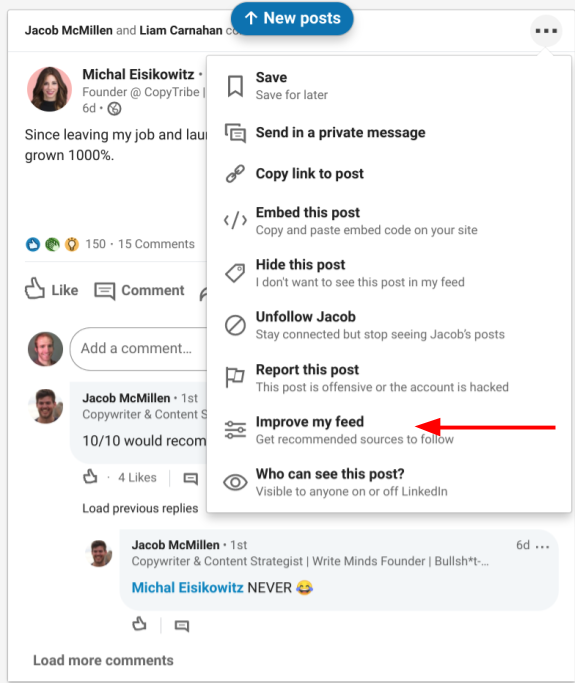
From there, you can find new people and topics to follow, and can also choose to hide certain people or topics as you’d like.
(You can also unfollow individuals without severing ties with them completely—which you almost never want to do.)
The more you use LinkedIn strategically and intentionally, the more personalized your newsfeed will become over time.
In turn, you’ll start seeing much more relevant content—which you can then share with those you’re looking to attract.
Discovering the right content
There are many ways to discover new and engaging content on LinkedIn.
For social selling purposes, Low suggests the following methods:
Browse trending hashtags: Using the “Improve My Feed” tool, you can discover numerous hashtags used and followed by your target audience. Once you follow these hashtags, your newsfeed will begin showcasing articles this audience is likely to interact with.
Browse “Today’s news and views”: Near the top-right of your newsfeed you’ll find the day’s top stories related to the topics you follow—which, incidentally, will be the topics your target audience is most interested in.
Searching for content: You can use LinkedIn’s search feature to find content related to specific keywords. Just search for a topic, then click “Content” at the top of the results page to find content those in your network are sharing and engaging with.
The goal here is to understand what topics and content types your target audience reads and engages with.
Once you know what your audience is reading, you can start engaging with this content to gain some visibility in front of this same group of prospects.
Engaging with shared content
The simplest way to get on the radar of dozens—even hundreds—of potential clients on LinkedIn is to interact with content they or a mutual connection have engaged with.
In the webinar, Low shows us an example where he simply likes a post by Goldman Sachs. In turn, his name may pop up when others who follow Goldman Sachs view the same post.
You can increase the chances of this happening by leaving a thought-provoking comment on the post, as well.
Or, you could take matters into your own hands and engage directly with others who have commented on the post.
By using content your audience is interested in as a springboard for engagement, you’ll provide clear context for your relationship to be built on.
Then, you can immediately start delivering value to your new prospects—and get them moving toward conversion just as quickly.
Conclusion
The goal of this webinar is to help you set up your LinkedIn profile and presence for social selling purposes.
Note, though, that very little—if anything—we discussed has to do with actually selling on LinkedIn.
As Low makes clear throughout the webinar, you shouldn’t be using LinkedIn to pitch to prospects at all.
Rather, LinkedIn is where you’ll be forging and nurturing authentic relationships with potential clients in a no-pressure, no-strings-attached manner.
Once you’ve piqued their interest and gained their trust, you’ll be in prime position to take the conversation off LinkedIn—and start working toward converting your new leads.
Note: Want to get a head start on targeting the right audience on LinkedIn? Use You can try Leadfeeder free for 14 days here to see what companies visiting your site—and target others just like them.
Now that you're here
Leadfeeder is a tool that shows you companies that visit your website. Leadfeeder generates new leads, offers insight on your customers and can help you increase your marketing ROI.
If you liked this blog post, you'll probably love Leadfeeder, too.
Sign up







